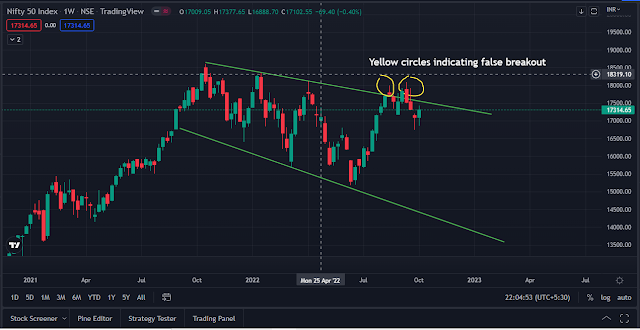What next...........?
Hello everyone......
There is lot of confusion in retail traders and investors due to recent behaviour of stock market. I thought, It's right time to restart my blogs after too long gap. So now Oct. 2022 ongoing as we all know.... nothing special about it but one year ago Nifty 50 index busy in making All time High which not break for almost one year. During Sept 2021to Oct. 2021 I was continuously posting on all social media handle about that was perfect time to take exit because Oct 2021's top will be long lasting. Last alert I was posted in 1st week of Oct 2021. Also in Muhurat trading session said don't buy heavily wait for correction.
Whole thing I was repeating because friends, situation still not changed even we can say situation get more worse. Global institution including IMF, UNCTAD are cutting down India's GDP forecasts every other month, for which we already said don't get exited due to forecasting good numbers it can change when actual numbers about to release. We are not going much in details of macro economics but the way these institution cutting down forecasted number you can apply logic how Macro Economic indicators hits badly in negative way. Next thing which We consider largely which directly impacting equity market. 1. Crude oil Prices 2. USDINR rate.
Crude Pricing Factor:
Crude Prices topping out around 2008 at $147 After that The prices was stayed in favour of oil importing countries. And such countries get benefited from it to grow their economies. Now since Ukraine-Russia event prices shoot up and made top of $138 and later cool down but not much. For India average Crude prices around $65 sustainable. Any large upside deviation from that mark not good for India. Current price of Crude $98 very badly hitting Indian economy. And as per analysis prices are going up in near time, expected to grow price to $125. This triggering hike in transporting cost which will reflecting in inflated price of Row and finish materials. Whenever Crude prices on fire all oil importing cou8nties feel that heat. It reduces margins which evaporate the profits of companies. As profits decreasing prices of stocks also get reducing.
USDINR:
USDINR rate is like putting petrol into the fire now a days.
USDINR rate was 65 around FY 2019 and now in Oct 2022 USDINR rate is 82+. Which directly impacting oil import bills of India.
1. E.g. in FY 2019 USDINR rate 65 & Crude at $70
Price of 100 Barrels of Crude in 2019 = $70*65 = Rs. 4550
2. E.g. in FY 2022 USDINR rate 82 & Crude at $98
Price of 100 Barrels of Crude in 2022 = $98*82 = Rs. 8036
Above mentioned prices does not included Transportation and Insurance cost of Crude oil.
We are paying almost double for same crude in just 3 years.
As mentioned above about CRUDE & USDINR relation, the relation looks like worst for doing investment in Equity. When there is dark clouds over equity investment then you can move your investments in other asset class like Bonds, Physical gold, and Real estate in Tier 1 & 2 cities. Never put your all money in Equity. There much good real estate investments that can gives return more than stock market returns.
For investing in Equity in current era you can put 10% cash after each quarter ends only in fundamentally good stocks. or Whatever stocks you want to buy, divide current price of stock by 2 and put alert price for that and buy once price reaches there.
Mayur Jagtap
For regular and daily small update
Join Telegram- https://t.me/mycapitalchoice
Join on Facebook- https://m.facebook.com/mycapitalchoice




Comments
Post a Comment